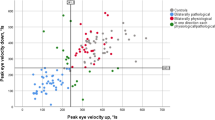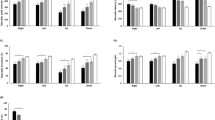Abstract
Objective
Selective posterior rhizotomy (SPR) represents a standard neurosurgical approach in the treatment of spasticity in children with cerebral palsy (CP). Beside the reduction of spasticity in lower limbs, SPR may have suprasegmental effects, considerably above the surgery site. In this communication, we report on the improvement of smooth pursuit eye movements (SPEM) in two children after SPR.
Material and methods
Four children with CP underwent SPR. Eye movements were registered by infrared video-oculography before and after the surgery.
Results
The analysis of SPEM showed the improvement of the correlation coefficient of the eye response to the stimulus after SPR in two subjects. Improvement of SPEM performance was largely due to suppression of spontaneous fixation nystagmus.
Conclusion
SPR may lead to the improvement of SPEM in children with CP. The influence of SPEM improvement on quality of life in a group of severely disabled nonambulant children with CP remains to be assessed.


Similar content being viewed by others
References
Craft S, Park TS, White DA, Schatz J, Noetzel M, Arnold S (1995) Changes in cognitive performance in children with spastic diplegic cerebral palsy following selective dorsal rhizotomy. Pediatr Neurosurg 23:68–74
Fasano VA, Barolat-Romana G, Ivaldi A, Sguazzi A (1976) Functional posterior radiculotomy, in the treatment of cerebral spasticity, peroperative electric stimulation of posterior roots and its use in the choice of the roots to be sectioned. Neurochirurgia 22:23–34
Jackson J, Castleberry C, Galli M, Arnoldi KA (2006) Cerebral palsy for the pediatric eye care team—part II: diagnosis and treatment of ocular motor deficits. Am Orthopt J 56:86–89
Jan JE, Lyons CJ, Heaven RK, Matsuba C (2001) Visual impairment due to a dyskinetic eye movement disorder in children with dyskinetic cerebral palsy. Dev Med Child Neurol 43:108–112
Katayama M, Tamas LB (1987) Saccadic eye-movements of children with cerebral palsy. Dev Med Child Neurol 29:36–39
Loewen P, Steinbok P, Holsti L, MacKay M (1998) Upper extremity performance and self-care skill changes in children with spastic cerebral palsy following selective posterior rhizotomy. Pediatr Neurosurg 29:191–198
McClelland JF, Parkes J, Hill N, Jackson J, Saunders KJ (2006) Accommodative dysfunction in children with cerebral palsy: a population-based study. Invest Ophthalmol Vis Sci 47:1824–1830
Miller AC, Johann-Murphy M, Cate IM (1997) Pain, anxiety, and cooperativeness in children with cerebral palsy after rhizotomy: changes throughout rehabilitation. J Pediatr Psychol 22:689–705
Ojemann JG, McKinstry RC, Mukherjee P, Park TS, Burton H (2005) Hand somatosensory cortex activity following selective dorsal rhizotomy: report of three cases with fMRI. Childs Nerv Syst 21:115–121
Peacock WJ, Arens LJ (1982) Selective posterior rhizotomy for the relief of spasticity in cerebral palsy. S Afr Med J 62:119–124
Salati R, Borgatti R, Giammari G, Jacobson L (2002) Oculomotor dysfunction in cerebral visual impairment following perinatal hypoxia. Dev Med Child Neurol 44:542–550
Shagass C, Roemer RE, Amadeo M (1976) Eye-tracking performance and engagement of attention. Arch Gen Psychiatry 33:121–126
Steinbok P, Langill L, Cochrane DD, Keyes R (1992) Observations on electrical stimulation of lumbosacral nerve roots in children with and without lower limb spasticity. Childs Nerv Syst 8:376–382
Tichy M, Kraus J, Horinek D, Vaculik M (2003) Selective posterior rhizotomy in the treatment of cerebral palsy, first experience in Czech Republic. Bratisl Lek Listy 104:54–58
Woods TM, Cusick CG, Pons TP, Taub E, Jones EG (2000) Progressive transneuronal changes in the brainstem and thalamus after long-term dorsal rhizotomies in adult macaque monkeys. J Neurosci 20:3884–3899
Acknowledgment
The study is supported by IGA MZ grant NR 8318/3.
Author information
Authors and Affiliations
Corresponding author
Rights and permissions
About this article
Cite this article
Hořínek, D., Hoza, D., Černý, R. et al. Two cases of improvement of smooth pursuit eye movements after selective posterior rhizotomy. Childs Nerv Syst 24, 1283–1288 (2008). https://doi.org/10.1007/s00381-008-0673-x
Received:
Published:
Issue Date:
DOI: https://doi.org/10.1007/s00381-008-0673-x




